Apple iPad 2 Preview
by Anand Lal Shimpi, Brian Klug & Vivek Gowri on March 12, 2011 6:01 AM ESTI remember the speculation that lead up to Apple's iPad launch. The list of things everyone expected the device to do was absurd, and the theories on the architecture behind Apple's first branded SoC was just as fantastic. The simplest answer is sometimes the right one and as Ars Technica's Jon Stokes pointed out, the A4 was nothing more than a hardened ARM Cortex A8 core running at 1GHz in the iPad (and 800MHz in the iPhone 4).

The Cortex A8 is something we've covered extensively here so I won't go into great detail right now. It's a dual-issue, in-order architecture with a 13 stage integer pipeline and a non-pipelined FPU.
When Apple announced the iPad 2, it also briefly announced the A5 SoC. The only detail given? The A5 is a dual-core processor with a GPU that's 9x faster than what's in the A4.

There are only two recent ARM architectures that have multicore support: the ARM11 and the ARM Cortex A9. The A8 doesn't come in a multicore variant. Given how many other SoC vendors are shipping dual-core Cortex A9 SoCs, the A5 was likely no different than NVIDIA's Tegra 2, TI's OMAP 4 or Samsung's Exynos in that regard: armed with a pair of Cortex A9s running at 1GHz. Update: Geekbench reports clock speed at 900MHz. Update 2: Apple confirms 1GHz clock speed on the iPad 2 specs page.
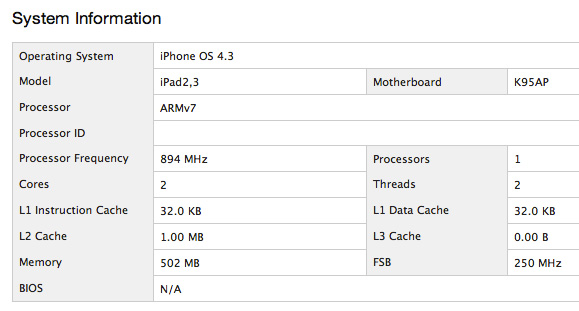
| Architecture Comparison | |||||||
| ARM11 | ARM Cortex A8 | ARM Cortex A9 | Qualcomm Scorpion | ||||
| Issue Width | single-issue | dual-issue | dual-issue | dual-issue | |||
| Pipeline Depth | 8 stages | 13 stages | 9 stages | 13 stages | |||
| Out of Order Execution | N | N | Y | Partial | |||
| FPU | Optional VFPv2 (not-pipelined) | VFPv3 (not-pipelined) | Optional VFPv3-D16 (pipelined) | VFPv3 (pipelined) | |||
| NEON | N/A | Y (64-bit wide) | Optional MPE (64-bit wide) | Y (128-bit wide) | |||
| Process Technology | 90nm | 65nm/45nm | 40nm | 40nm | |||
| Typical Clock Speeds | 412MHz | 600MHz/1GHz | 1GHz | 1GHz | |||
The Cortex A9 is similar to the A8 but with an out-of-order execution engine and a shallower pipeline (9 stages). The result is better-than-A8 performance at the same clock speed. The A9 also adds a fully pipelined FPU.
Now it's unclear what the rest of the A5 SoC looks like, but from the CPU standpoint I think it's safe to say that there are a pair of ARM Cortex A9s in there. We can look at the increase in Geekbench Floating Point scores for some proof:
| Geekbench 2 - Floating Point Performance | ||||
| Apple iPad | Apple iPad 2 | |||
| Overall FP Score | 456 | 915 | ||
| Mandlebrot (single-threaded) | 79.5 Mflops | 279.1 Mflops | ||
| Mandlebrot (multi-threaded) | 79.4 Mflops | 554.7 Mflops | ||
| Dot Product (single-threaded) | 245.7 Mflops | 221.7 Mflops | ||
| Dot Product (multi-threaded) | 247.2 Mflops | 436.8 Mflops | ||
| LU Decomposition (single-threaded) | 54.5 Mflops | 205.4 Mflops | ||
| LU Decomposition (multi-threaded) | 54.8 Mflops | 421.6 Mflops | ||
| Primality Test (single-threaded) | 71.2 Mflops | 177.8 Mflops | ||
| Primality Test (multi-threaded) | 69.3 Mflops | 318.1 Mflops | ||
| Sharpen Image (single-threaded) | 1.51 Mpixels/s | 1.68 Mpixels/s | ||
| Sharpen Image (multi-threaded) | 1.51 Mpixels/s | 3.34 Mpixels/s | ||
| Blur Image (single-threaded) | 760.2 Kpixels/s | 665.5 Kpixels/s | ||
| Blur Image (multi-threaded) | 753.2 Kpixels/s | 1.32 Mpixels/s | ||
Single threaded FPU performance is multiples of what we saw with the original iPad. This sort of an improvement in single-core performance is likely due to the pipelined Cortex A9 FPU. Looking at Linpack we see the same sort of huge improvement:
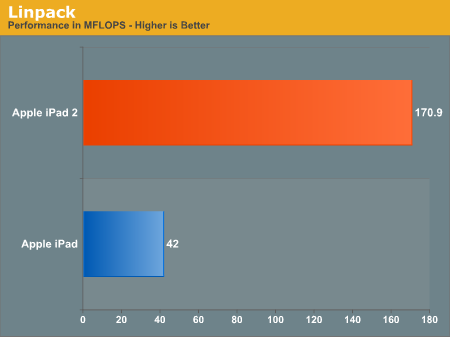
Whether this performance advantage matters is another matter entirely. Although there aren't many FP intensive iPad apps available today, moving to the A5 is all about enabling developers - not playing catch up to software.
Memory size, bandwidth and operating frequencies are all unknowns that I was hoping to find out more about once I put hands on the iPad 2. Geekbench reports the iPad 2 at 512MB of memory, double the original iPad's 256MB. Remember that Apple has to deal with lower profit margins than it'd like with the iPad, but it refuses to cut corners on screen quality so something else has to give.
L2 cache size has also apparently increased from 512KB to 1MB. The L2 cache is shared among both cores and 1MB seems to be the sweet spot this generation.
| Geekbench 2 - Memory Performance | ||||
| Apple iPad | Apple iPad 2 | |||
| Overall Memory Score | 644 | 787 | ||
| Read Sequential (single-threaded scalar) | 340.6 MB/s | 334.2 MB/s | ||
| Write Sequential (single-threaded scalar) | 842.4 MB/s | 1.07 GB/s | ||
| Stdlib Allocate (single-threaded scalar) | 1.74 Mallocs/s | 1.86 Mallocs/s | ||
| Stdlib Write (single-threaded scalar) | 1.20 GB/s | 2.30 GB/s | ||
| Stdlib Copy (single-threaded scalar) | 740.6 MB/s | 522.0 MB/s | ||
Geekbench's memory tests show an improvement in effective bandwidth as well. The biggest improvement is in the stdlib write test which shows a near doubling of bandwidth from 1.2GB/s to 2.3GB/s. Unfortunately this isn't enough data to draw conclusions about bus width or DRAM operating frequency. Given the increases in CPU and GPU performance, an increase in memory bandwidth to go along with the two isn't surprising.
Geekbench shows a healthy increase in integer performance, both in single and multithreaded scenarios. The multithreaded advantage makes sense (two are better than one), but the lead in single threaded tests shows the benefit the A9 can deliver thanks to its shorter pipeline and ability to reorder instructions around stalls.
| Geekbench 2 - Integer Performance | ||||
| Apple iPad | Apple iPad 2 | |||
| Overall FP Score | 365 | 688 | ||
| Blowfish (single-threaded) | 13.9 MB/s | 13.2 MB/s | ||
| Blowfish (multi-threaded) | 14.3 MB/s | 26.1 MB/s | ||
| Text Compression (single-threaded) | 1.23 MB/s | 1.50 MB/s | ||
| Text Compression (multi-threaded) | 1.20 MB/s | 2.82 MB/s | ||
| Text Decompression (single-threaded) | 1.11 MB/s | 2.09 MB/s | ||
| Text Decompression (multi-threaded) | 1.08 MB/s | 3.28 MB/s | ||
| Image Compress (single-threaded) | 3.36 Mpixels/s | 3.79 Mpixels/s | ||
| Image Compress (multi-threaded) | 3.41 Mpixels/s | 7.51 Mpixels/s | ||
| Image Decompress (single-threaded) | 6.02 Mpixels/s | 6.68 Mpixels/s | ||
| Image Decompress (multi-threaded) | 5.98 Mpixels/s | 13.1 Mpixels/s | ||
| Lua (single-threaded) | 172.1 Knodes/s | 273.4 Knodes/s | ||
| Lua (multi-threaded) | 171.9 Knodes/s | 542.9 Knodes/s | ||
On average Geekbench shows a 31% increase in single threaded integer performance over the A4 in the original iPad. NVIDIA told me they saw a 20% increase in instructions executed per clock for the A9 vs. A8 and if we remove the one outlier (text decompression) that's about what we see here as well.
| Geekbench 2 | |||||||
| Overall | Integer | FP | Memory | Stream | |||
| Apple iPad | 448 | 365 | 456 | 644 | 325 | ||
| Apple iPad 2 | 750 | 688 | 915 | 787 | 324 | ||
The increases in integer performance and memory bandwidth are likely what will have the largest impact on your experience. The fact that we're seeing big gains in single as well as multi-threaded workloads means the performance improvement should be universal across all CPU-bound apps.
What does all of this mean for performance in the real world? The iPad 2 is much faster than its predecessor. Let's start with our trusty javascript benchmarks: SunSpider and BrowserMark.
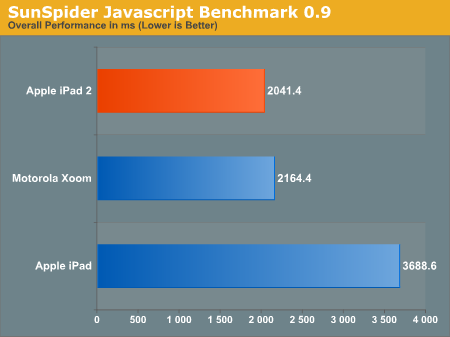
Apple improved the Safari JavaScript engine in iOS 4.3, which right off the bat helped the original iPad become more competitive in this test. Even with both pads running iOS 4.3, the iPad 2 is 80% faster than the original iPad here.
The Motorola Xoom we recently reviewed scored a few percent slower than the iPad 2 in SunSpider as well. Running different OSes and browsers, it's difficult to conclude much when comparing the A5 to Tegra 2.
A bug in BrowserMark kept us from running it for the Xoom review but it's since been fixed. Again we're looking at mostly JavaScript performance here. Rightware modeled its benchmark after the JavaScript frameworks and functions used by websites like Facebook, Amazon and Gmail among others. The results are simply one aspect of web browsing performance, but an important one:

The move from the A4 in the iPad 1 to the A5 in the iPad 2 boosts scores by 47%. More impressive however is just how much faster the Xoom is here. I suspect this has more to do with Google's software optimizations in the Honeycomb browser than hardware, but let's see how these tablets fare in our web page loading tests.
We debuted an early version of our 2011 web page loading tests in the Xoom review. Two things have changed since then: 1) iOS 4.3 came out, and 2) we changed our timing methods to produce more accurate results. It turns out that Honeycomb's browser was stopping our page load timer sooner than iOS', which resulted in some funny numbers when we got to the 4.3/Honeycomb comparison. To ensure accuracy we went back to timing by hand (each test was repeated at least 5 times and we present an average of the results). We also added two more pages to the test suite (Digg and Facebook).

The iPad 2 generally loads web pages faster than the Xoom. On average it's a ~20% increase in performance. I wouldn't say that the improvement is necessarily noticeable when surfing most sites, but it's definitely measurable.
The move to iOS 4.3 really narrowed the gap between the original iPad and the Xoom. In some cases the two actually render pages in the same amount of time, however that's typically for lighter pages that are easy to render. Up the complexity and the Xoom easily distances itself from the original iPad.
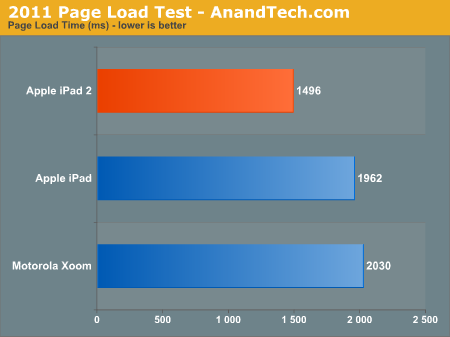
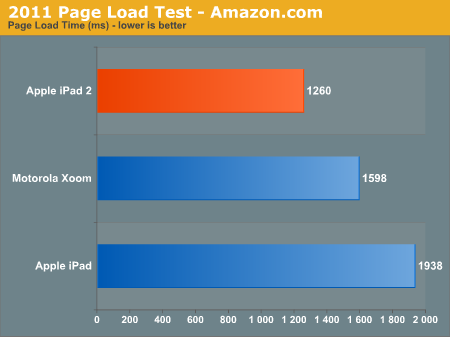
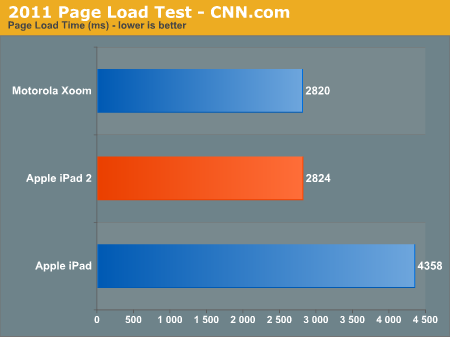

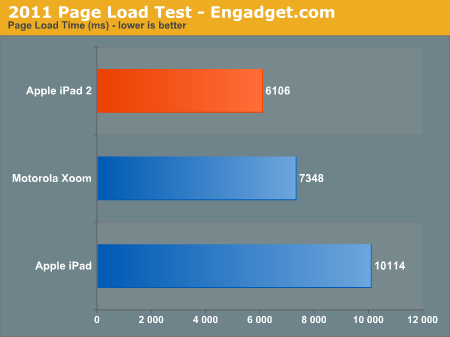

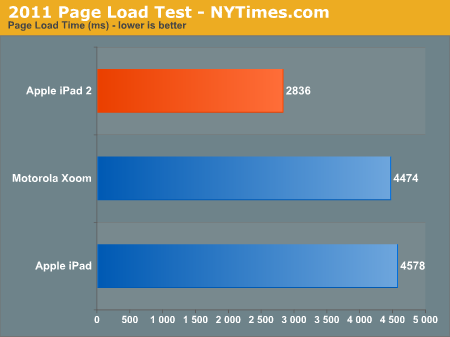
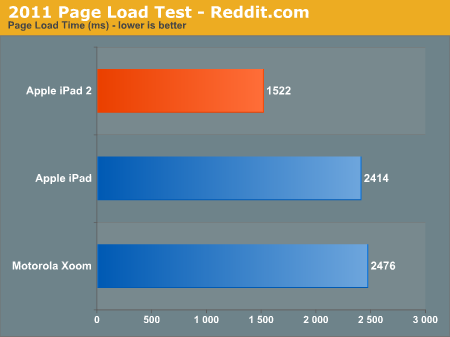
We'll touch on this more in the full review but it's not all about performance when talking about web browsing between the iPad 2 and the Xoom. Although the iPad 2 may have faster render times on average, the Xoom still supports tabbed browsing which definitely has its advantages.










82 Comments
View All Comments
erple2 - Tuesday, March 15, 2011 - link
In the iOS case - they're synonymous. You can't get the "new" browser without also getting the new OS update.tipoo - Saturday, March 12, 2011 - link
In addition to software differences, each company also tweaks the design of the Cortex A9 to their liking. After ARM licences it out they can do pretty much whatever to it. So you might see Qualcomm adding cache, Nvidia doubling the bus, or whatever.metafor - Tuesday, March 15, 2011 - link
ARM core licenses do not allow you to modify the CPU design. ARM allows different options when configuring cache size and bus width and co-processors but only with their macro-generator. There's definitely flexibility, but it's not "whatever you want". There are limited flavors if you will of yummy goodness.Anand Lal Shimpi - Saturday, March 12, 2011 - link
While the underlying architecture between those devices may be similar, there are some differences. For example NVIDIA's Tegra 2 only has a single channel 32-bit LPDDR2 memory interface while TI's OMAP 4 has a dual-channel LPDDR2 memory interface.Tegra 2 also lacks an MPE (SIMD engine) while the OMAP 4 doesn't.
Take care,
Anand
tipoo - Saturday, March 12, 2011 - link
I'd be interested in a comparison between all these mobile processors. I understand its difficult since the iPad uses a different OS, but given the numbers where do you think it stands compared to Tegra 2 and the like?zhill - Saturday, March 12, 2011 - link
My understanding is that the ARM Cortex A9 is just an instruction set and architecture specification/chip design. Each company manufactures the actual chips themselves so they can make additional changes at the hardware level such as lithography, voltage, clock frequency, cache sizes etc. So they license the design from ARM, but build the silicon themselves so each design may vary in terms of actual implementation and performance.Software also certainly makes a difference.
winterspan - Saturday, March 12, 2011 - link
you are right to an extent. There are actually two different licenses, a manufacturing license and a "design" license. Basically, if you pay more for the design license, they can make a custom core that implements the ARM Cortex v7 instruction set. This is what Qualcomm does with their Snapdragon. Most of the other guys just have the manufacturing license and this enables mild adjustments, but essentially they all have to use a similar Cortex-A9 core.Not sure what the Apple cores are... Standard Cortex-A9 or something more custom from Intrinsity/Samsung?
jmmx - Sunday, March 13, 2011 - link
"If Apple iPAD 2, NVIDIA's Tegra 2, TI's OMAP 4 and Samsung's Exynos all use the same Dual Core ARM Cortex A9…"There is more to it than this. The simple fact is they do NOT "use the same Cortex A9." They each user their own implementation of the A9. Additionally, A9 is the core cpu design, but the chips are SoC chips "System on a Chip" That is, they contain a lot more than just the A9 CPU but other non CPU functional units as well.The configuration of these units can significantly affect performance.
This is my understanding of the situation. (Caveat - I am a software engineer not hardware.) Someone out there feel free to correct me if I am mistaken about this.
str1ke007 - Saturday, March 12, 2011 - link
Can the ipad2 be tetherd to an iphone ?? (so i can use the 3G data i allready pay for rather then paying for another sim/plan)kmmatney - Saturday, March 12, 2011 - link
There is no reason why you couldn't, and this is what I plan on doing. However I would like to know if the map and GPS apps work well on an iPad without 3G. Do you need to get a 3G for the GPS to work properly?